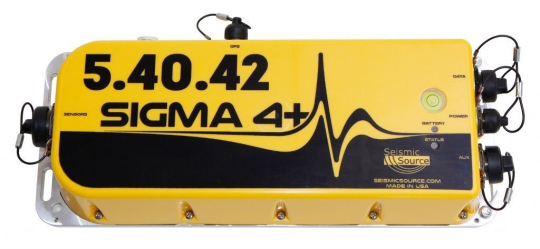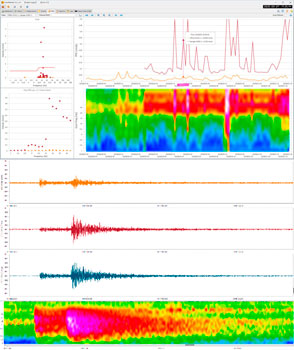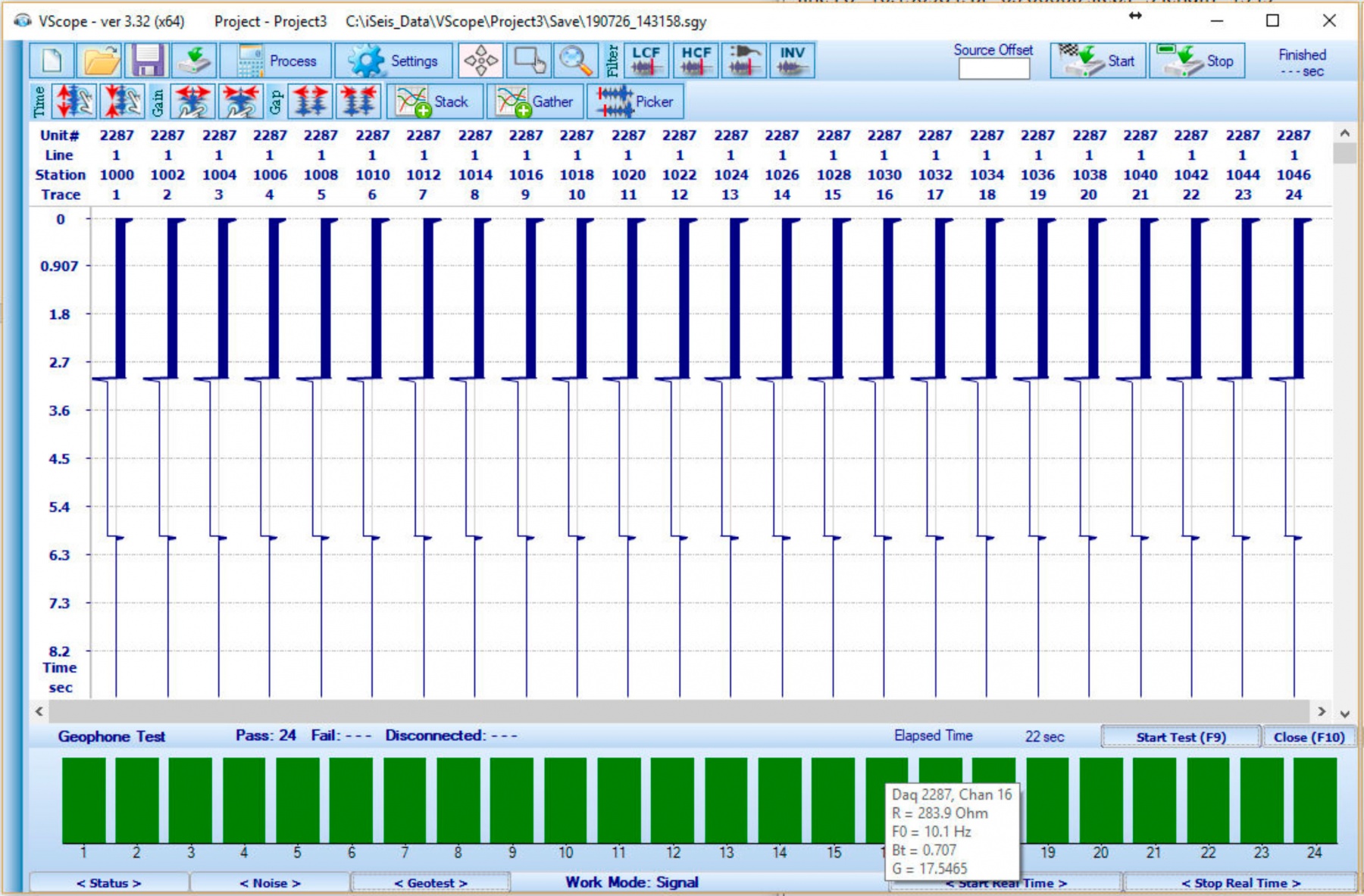Sigma 4+ seismograph for surveys and monitoring
Sigma 4+ is a miniature 4-channel version of the DAQlink4 seismograph. Excellent metrological characteristics, continuous recording capability, high-frequency ADC, built-in or external GNSS receiver, remote access, optional built-in battery and 3C geophone, work with external low-frequency receivers, plug-in anemometer and much, much more, make this seismograph the best choice for the widest range of tasks.
The VSP with the GStreamer-E 3C probe or the WellStreamer hydrophone streamer
The Sigma 4+ is the optimal seismic seismograph for different methods of VSP, both for seismic waves velocity estimation along the borehole and for dynamic section plotting. Four recording channels allow performing observations with a 3C probe or a 3-channel hydrophone streamer and a reference geophone receiver, which provides the possibility of accuracy evaluation and correction of source-seismic seismograph synchronization error.
Parallel CST according to ASTM D4428 / D4428M
The method allows to reconstruct the velocity profile of P-waves and S-waves of rocks in situ with horizontal direction of waves propagation along the layer, i.e. without taking into account the velocity anisotropy related to thin layering (macroanisotropy) or geological formations consisting of small elements of two different substances (microanisotropy). Observations are performed in two parallel boreholes with a distance of 3 to 6 m between them. Generation of pressure (P) and shear (S) waves is executed using a borehole sparker Pulse and electrodynamic sources SHock and GeoSV. Signal receiving is provided by the GStreamer-E 3C probe and the WellStreamer hydrophone array. A description of CST technology can be found in ASTM D4428 / D4428M or in our publications.
Pile Length Testing, Base plate and Tunnel lining quality inspection
With its high-frequency ADC, the Sigma 4+ is perfect for almost any geotechnical task. For pile length testing (Pile Integrity Testing) and inspection of the footings (impact method), special high-frequency sensors GTSensor are connected to the seismograph. On foundation slabs, it is more convenient to use 4-channel LandStreamer towed seismic sensors as a receiver. The data can be processed in the GeoTechControl software.
Monitoring of microseisms, earthquakes, explosions, hydraulic fracturing and any other events
The seismograph allows continuous long-term data recording to built-in and external data storage devices with hot swapping capability without data loss. Timing is provided by a built-in or external GNSS receiver, a wired or wireless synchronization link between seismographs or by the seismograph's internal high-stability clock. The Sigma 4+ can be optionally equipped with a built-in or external 2 Hz 3C seismic receiver, an internal battery and a detachable external low-frequency geophone. The seismograph case is equipped with a bubble level and has the possibility of screwing pins directly into its base. The Sigma 4+ is a perfect solution to perform any type of seismic monitoring, thanks to its dedicated software, multiple networking options, remote configuration and data download, continuous or auto-start recording based on a trigger signal or LTA (Long Term Average)/STA (Short Term Average) events with email notification capability.
Passive MASW and the Nakamura method
The task of recording surface waves from stochastic or industrial sources as well as recording microseisms for subsequent calculation of H/V spectral ratios is successfully performed by the Sigma 4+ seismograph with an integrated or external mid-frequency (2 Hz) 3C sensor, connected external geophones (from 4.5 Hz) and low-frequency seismometers, accelerometers or torsional transducers.
Seismic survey in mines or dense urban building
It is not always possible to realize synchronization between the source and the seismograph. It can be extremely problematic or impossible to deploy a wired synchronization line between the mines or from the tunnel to the surface while testing, and using a radio channel in these cases is simply not feasible. Seismic surveys in the city often impose similar restrictions. DAQlink4 and Sigma 4+ seismographs can keep long-term records on the built-in and external storage with time reference from the GNSS signal and an autonomous high-stability clock. One seismograph can be connected to the receiving array and the other to the source for shooting log formation - this allows performing synchronization in post-processing, i.e. to slice standard seismograms from the data array.
High Resolution Marine Seismic
The fast and reliable Sigma 4+ and DAQlink4 high-frequency seismographs are excellent for 2D or 3D high-resolution marine seismic acquisition with the HRStreamer-1 towed streamer with a unique adjustable hydrophone array or the advanced 48-channel HRStreamer-48. A more complete description of the capabilities of the seismographs, towed water sources, and other necessary equipment can be found in a dedicated section. We also provide high-resolution marine data processing services.
- Possibility to combine seismographs in a single array using twisted pair (length up to 3 km), Ethernet, Wi-Fi or GSM modems
- Any recording duration up to continuous recording
- Wide bandwidth of the recorded signal: 0 to 20,000 Hz
- Capability of remote control, setup, recording and data downloading via Wi-Fi, Gigabit Ethernet or cellular connection. Built-in FTP server
- Geophone test: frequency, impedance, attenuation and other features
- VHF / UHF radio or twisted pair wired synchronization (up to 3km) for use in mines
- Continuous logging with GNSS time synchronization
- Built-in 99.9 Wh battery
- Multiple triggering options: source sensor trigger, LTA (Long Term Average) and STA (Short Term Average) event, TTL pulse, and more. Even email notification is possible if an expected LTA or STA event is detected
- Register data from any type of source. Supports Force 3 controllers
- Built-in 16 GB memory for independent data recording and flash drive connection for data backup and transfer
- Built-in tools for seismograph test (distortion factor, mutual interference between the channels, common mode rejection, inherent noise level) and geophones test (impedance, frequency, attenuation, sensitivity)
- Data can be saved in the formats SEG-2, SEG-D, SEG-Y, ASCII or MiniSEED
- Sigma 4+ seismograph
- Cable set
- Software
- 2 Hz 3C built-in or external low-frequency receiver
- Low-frequency seismometers, accelerometers and torsional transducers
- Wi-Fi option
- Mesh Radio Network module
- GSM modem
- High-frequency sensor GTSensor
- LandStreamer 4-channel array
- Pile Length Testing kit
- External USB data storage device
- Built-in or external GNSS receiver
- Built-in rechargeable battery (99.9 Wh)
- Solar panel
- Anemometer
- Marine and downhole seismic acquisition equipment
- Event monitor and Tremor cloud for microseismic surveys, seismic monitoring, earthquake recording, hydraulic fracture and injection monitoring
- Vscope and Bgr to collect data from different types of seismic sources
- DataCollection for data acquisition with track visualization
- Visualiser for data visualization and conversion to other formats
- Earthquake Locator for locating the epicenter
- Harvest for stacking
|
Number of channels in one station |
4 ch. |
|
ADC capacity |
24, Σ-Δ bits |
|
Dynamic range |
127 dB (@ 500 Hz) |
|
Preamplifier gain |
×1 (0 dB), ×4 (12 dB), ×16 (24 dB) |
|
Sample rate |
125; 250; 500; 1000; 2000; 4000; 8000; 16000; 32000; 64000 Hz |
|
Maximum record length |
unlimited |
|
Frequency range |
0 ÷ 20 000 Hz |
|
Anti-aliasing filter |
80% of Nyquist frequency |
|
High Pass Filter |
0.001 ÷ 120 Hz, digital |
|
Filter type |
linear-phase |
|
Trigger accuracy |
±1 (@ 500 Hz) μs |
|
Maximum input signal with minimum gain |
±3 V |
|
The level of inherent noise of the registering channel |
< 0.15 µV (@ 500 Hz) |
|
Non-linear distortion coefficient |
0.0001 % (@ 500 Hz) |
|
Mutual interference between channels |
125 dB |
|
Common mode suppression factor |
100 dB (@ 500 Hz) |
|
Power consumption |
0.4 W/channel |
|
Input impedance |
100 kOhm |
|
Time synchronization |
GNSS receiver or VHF |
|
Data storage capacity (16 Gb CF internal memory) |
720 hours (4 channels @ 500 Hz, 16 Gb) |
| Maximum capacity of external USB flash drive | up to 2TB |
|
Hot swap external USB drive without data loss |
yes |
|
Data format |
SEG-2, SEG-D, SEG-Y, ASCII, MiniSEED, SEEDlink |
|
LEDs |
2 LEDs for displaying battery status and operating mode |
|
Power |
10 – 28 V DC |
|
Temperature range |
-40 ÷ +80 °C |
|
Operating humidity |
0 ÷ 100 % |
|
Dimensions |
360×150×75 mm |
|
Weight without additional extensions |
1.5 kg |
|
Possibility of optional installation of devices and sensors |
- GNSS receiver - 2 Hz 3C geophone - rechargeable battery 99.9Wh - single-board computer with Linux for real-time data processing, acquisition or transmission via radio channel (Linux option)
- solar panel |
|
External devices connectivity |
external USB storage device, radio access point, Wi-Fi module, GSM modem, GNSS receiver, anemometer |
|
Connectors |
- 26 pins for geophones, ADC calibration and built-in sensors - 4 pins for external GNSS receiver - 10 pins for Ethernet connection - 3 pins external power supply - 19 pins for external USB drive or trigger line Optional: - USB for cloud storage connection (Linux option) |





